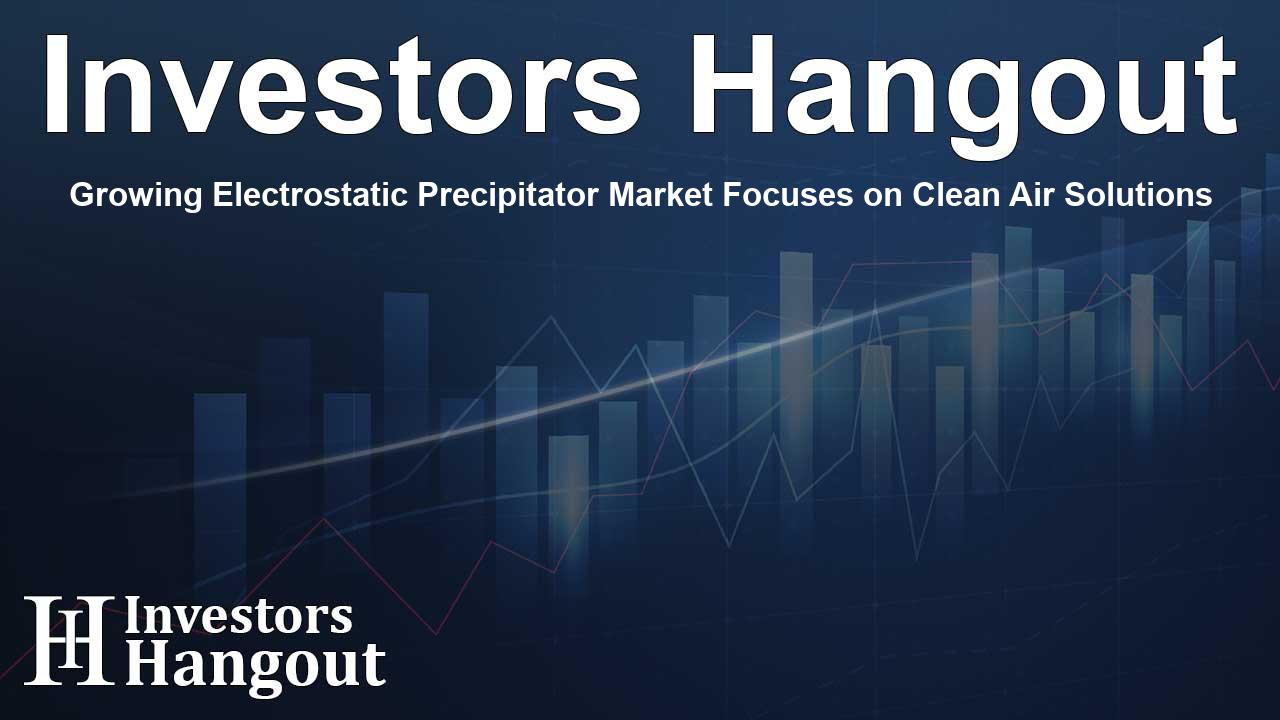Growing Electrostatic Precipitator Market Focuses on Clean Air Solutions

Electrostatic Precipitator System Market Insights
The Electrostatic Precipitator System Market is experiencing remarkable growth, driven by the increasing demand for effective air pollution control solutions. As industries become more aware of the importance of complying with stringent environmental regulations, investments in advanced pollution control technologies are on the rise. Numerous sectors, including power generation, cement, and steel, are adopting these technologies to reduce emissions and mitigate their environmental impact. The heightened awareness of air pollution’s detrimental effects on public health has also generated a surge in demand for high-efficiency precipitators, capable of capturing fine particles and pollutants effectively.
Market Growth Projections
Recent analyses indicate that the market is expected to expand significantly, projecting growth from USD 12.3 billion in the near future to around USD 17.1 billion by 2031, reflecting a compound annual growth rate (CAGR) of approximately 4.8%. The growth trajectory is closely linked to rising regulatory demands and the necessity for robust air pollution control in key industrial domains, particularly power generation, cement production, and steel manufacturing.
Technological Developments
Technological advancements in Electrostatic Precipitator (ESP) systems are enhancing their efficiency and effectiveness. Modern ESPs are designed to capture ultrafine particles while minimizing energy consumption. The integration of hybrid ESP systems, which combine traditional electrostatic precipitation with additional filtration methods, is making these systems even more effective. Furthermore, the incorporation of automation and real-time monitoring features allows industries to have greater control over emissions and facilitates predictive maintenance, leading to consistent operational performance.
Regional Market Dynamics
The Electrostatic Precipitator System Market shows significant regional variability, with areas like Asia-Pacific leading the charge. Rapid industrialization in countries like China and India has led to substantial investments in air pollution control technologies due to severe air quality challenges. Both nations have established stringent environmental regulations, necessitating the implementation of effective ESP systems in various industries. North America and Europe also play crucial roles, buoyed by strong environmental policies and well-established industrial sectors prioritizing advanced pollution control solutions.
Key Industry Applications
The utilization of ESPs spans multiple industries, each with unique emissions control requirements. The power generation sector stands out as the largest user, where coal-fired and waste-to-energy facilities heavily rely on ESPs to manage particulate emissions. Other industries, including cement and steel manufacturing, also make significant use of these systems to tackle airborne pollutants from production processes. Additionally, chemical and petrochemical sectors benefit from ESP technology for managing volatile organic compounds (VOCs) and fine particles.
Challenges and Opportunities
Despite the favorable market conditions, several challenges persist. High installation and maintenance costs remain a barrier, especially in emerging markets where budget constraints are common. Companies face ongoing expenses related to regulatory compliance, necessitating routine monitoring and maintenance. Competing technologies such as fabric filters also present challenges, as they provide similar efficiency levels in particulate matter removal. The diversity of regional environmental regulations creates complexity in developing standardized ESP solutions, which can sometimes hinder adoption in less regulated areas.
Competitive Landscape
The competitive environment within the Electrostatic Precipitator System Market is intense, with key players investing heavily in research and development to improve system efficiency and reduce costs. Major companies like Mitsubishi Hitachi Power Systems and Siemens AG are at the forefront, delivering customized solutions tailored to industry-specific needs. Partnerships, mergers, and acquisitions are strategies often employed by these firms to enhance technological capabilities and broaden market presence while focusing on sustainability initiatives to align with global environmental goals.
Future Market Outlook
Looking to the future, the Electrostatic Precipitator market is poised for steady growth, driven by increasing industrial activity, particularly in emerging economies. Innovations aimed at improving energy efficiency and lowering operational costs will be key drivers of market expansion, as businesses seek compliance with tightening regulations through cost-effective technologies. The rising integration of IoT for real-time monitoring within ESP systems is expected to gain popularity, aligning with a global trend toward improved environmental management practices.
Geographic Insights
Geographic trends indicate that the Asia-Pacific region maintains a significant share of the ESP market. With rapid urbanization and industrial expansion, particularly in China and India, these countries are investing in advanced air filtration technologies to meet their growing pollution control needs. North America and Europe also hold substantial market shares due to established regulatory frameworks advocating cleaner industrial practices. As awareness of environmental issues increases globally, the demand for ESP systems is likely to grow across diverse industrial applications.
Frequently Asked Questions
What is an Electrostatic Precipitator?
An Electrostatic Precipitator is an air filtration device that uses electrostatic forces to remove particles from industrial exhaust gases, significantly improving air quality.
Which industries primarily use Electrostatic Precipitators?
Industries such as power generation, cement production, steel manufacturing, and the chemical sector predominantly use ESPs to control air pollution.
What are the key drivers of market growth for ESPs?
Key drivers include stringent environmental regulations, the need for effective air pollution control, and rising awareness of health risks associated with air contamination.
What challenges does the ESP market face?
The ESP market faces challenges such as high installation costs, maintenance expenses, and competition from alternative filtration technologies.
What is the future outlook for the Electrostatic Precipitator market?
The future outlook is positive, with anticipated growth driven by industrialization, technological advancements, and increased focus on sustainable practices globally.
About The Author
Contact Lucas Young privately here. Or send an email with ATTN: Lucas Young as the subject to contact@investorshangout.com.
About Investors Hangout
Investors Hangout is a leading online stock forum for financial discussion and learning, offering a wide range of free tools and resources. It draws in traders of all levels, who exchange market knowledge, investigate trading tactics, and keep an eye on industry developments in real time. Featuring financial articles, stock message boards, quotes, charts, company profiles, and live news updates. Through cooperative learning and a wealth of informational resources, it helps users from novices creating their first portfolios to experts honing their techniques. Join Investors Hangout today: https://investorshangout.com/
The content of this article is based on factual, publicly available information and does not represent legal, financial, or investment advice. Investors Hangout does not offer financial advice, and the author is not a licensed financial advisor. Consult a qualified advisor before making any financial or investment decisions based on this article. This article should not be considered advice to purchase, sell, or hold any securities or other investments. If any of the material provided here is inaccurate, please contact us for corrections.
